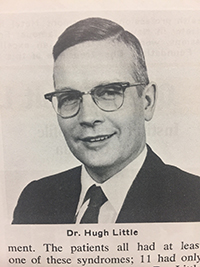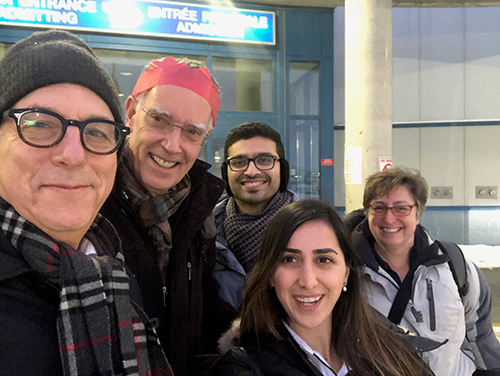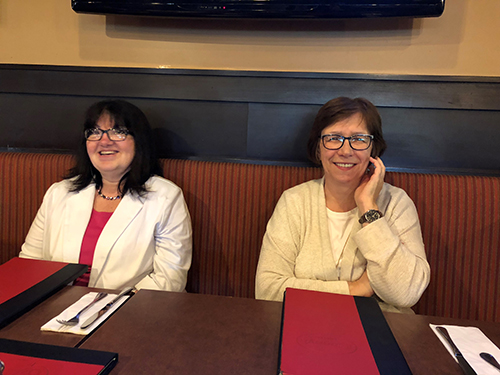Winter 2020 (Volume 30, Number 4)
Hugh's Legacy
Reflections from the Northern Ontario
Outreach Clinic
By Laurence Rubin, MD, FRCPC
Download PDF

In October 1992, Hugh Little died
suddenly. He was 58.
The previous spring, I had accepted
the offer of Division Head,
Rheumatology, at Women’s College
Hospital. I had discussed this with
him at length, and despite the impact
it would have on the Sunnybrook
Rheumatology Division, he
strongly encouraged me to apply
and supported my move. He was my
mentor, my friend and an invaluable
support during my post-doctoral
years. He had recruited me to Sunnybrook,
my first staff position. He
was a leader, with a demanding academic
and personal standard, but also a generous heart
and an acute sense of humour
And while I had performed limited clinical activities in
my years at Sunnybrook, one that I enjoyed immensely, was
our semi-annual visit to Timmins for the Arthritis Clinic.
Hugh had started this program in the early 1970s as a
travelling Arthritis Society program in Northeastern Ontario,
with Timmins as the natural hub. In those days, rheumatoid
arthritis (RA) management consisted of prescribing
aspirin and injectable gold, along with the judicious use of
steroids.
Many of the rheumatology residents who passed through
Sunnybrook accompanied Hugh on these trips; a Thursday
night arrival, check in and dinner at “The Senator,” the preferred
(and really only) hotel in town, frequented by mining
executives. The restaurant had a well-earned reputation for
its menu and wine list. The dinner was both liquid and filling,
but the next day at 7 a.m. it was time for a quick breakfast
and heading, by foot, to clinic. The late Bill Bensen told
me several times about the rigours of his frozen trudge up
the hill to St Mary’s.
In the late 80s, Hugh asked if I would be willing to join
him. The Sunnybrook rheumatology fellow at the time had
a mortal fear of flying and refused the offer. I immediately
said yes.
Following that visit, and at my request,
I became a regular. Thus my 30-plus-year
relationship with Timmins began.
When Hugh died suddenly, I was, by default,
in charge. The hospital was grateful
for my willingness to carry on and provide
what they had felt was an important and
critical service. This longstanding commitment
and relationship has served us all
well.
With a local population and catchment
area totalling 60,000, and a focus on inflammatory
rheumatic disease, predominantly
RA, we developed an effective, efficient
and sustained model of care. This has
been the result of multiple contributions,
and in particular our partnership with the Arthritis Society.
After Timmins local and long-tenured Arthritis Society
therapist Geraldine Carlier moved to Beirut, we were
incredibly fortunate to recruit Mary Ellen Marcon from
Sault Ste Marie. Mary Ellen was an inaugural graduate of
the Advanced Arthritis Practitioner Program (developed by
Rachel Shupak). I participated in the training program in
Toronto; it was there that I met Mary. Both on site as well
as through remote involvement, and with a deep first-hand
knowledge of the region, she has been critical to our success
over the years.
In 2000, Simon Carette joined the program. Simon had
a very close association with Hugh Little during his training
at Sunnybrook and beyond. In 1983, he co-authored
a classic paper on the natural history of ankylosing spondylitis.
Simon had participated in remote clinics while in
Quebec City, and I knew him to be a skilled clinician with a
keen sense of humour – an absolute requisite for Timmins,
and he was fluent in French!
In 2000, we moved to the new Timmins and District Hospital
(TADH). Over these past two decades, we have been extremely
fortunate to have skilled clinic nurses, coordinators
and volunteers, with whom we have established meaningful
relationships, despite our intense quarterly two-day visits.
We have sufficient space, the full spectrum of technologies and laboratory services, and all the needed pathways for
excellent rheumatologic patient care in the 21st century.
We have continuously engaged the primary care physician
groups directly and through continuing medical education
(CME). We even stayed for many years in an old mining executive
house converted to a bed and breakfast, owned by
one of the town’s longest serving family doctors. We have
eaten at almost all the reputable, and some less so, dining
establishments in town. Casey’s remains our diner of
choice, as Simon can always count on his favourite peanut
butter/brownie dessert!
In 2013, we began accepting patients from Kapuskasing,
after the sudden departure of the previous visiting rheumatologist.
Simon initially wanted to make separate day trips
there, but I reminded him it was 150 km away, on a two-lane
highway, and in the winter, we might encounter the occasional
moose! We have also received referrals from remote
Indigenous communities along James Bay, and met recently
with the local ophthalmologist to collaborate on the management
of uveitis.
Two and a half years ago, Simon and I agreed to offer an
elective for rheumatology fellows in Timmins. With the support
of the Rheumatology Disease Unit (RDU) Education
Director, Dr. Dana Jerome, we brought our first senior trainees,
Dr. Sahil Koppikar and then Dr. Bahar Moghaddam.
In typical Timmins’ experience, we even celebrated Bahar’s
birthday last December with champagne, “chilled” in the
hospital parking lot snow drifts!
And now, we have both stepped away. My last visit was
in June, virtually, of course, courtesy of the pandemic, but
Simon made it up to Timmins in early October. Mary Ellen,
after her more than two decades of dedicated service, retired
in 2018. We were fortunate again, with the support of the Arthritis
Society, to recruit Lynn Richards from Kingston, who
has now been thoroughly inculcated in the “Timmins way.”
Sahil expressed a keen interest in the program and excelled
from his first visit. I am very pleased that this past
July, he assumed my role as Director of the TADH Arthritis
program. Simon and I have every confidence in his skill and
vision. He will also recruit to replace Simon’s position.
These thirty-plus years have passed quickly. I am very
proud of what we have accomplished. We built and sustained
a model of inflammatory arthritis care, expanding
educational opportunities, and most importantly developing
a viable succession plan in a remote Northern community.
Sahil and his colleagues will undoubtedly evolve and
improve this program, and I look forward to watching the
changes.
We have been incredibly fortunate to be rheumatologists
in this golden age of our specialty. The Timmins clinic
is a microcosm and a living laboratory to effect and observe
the results of these advances in a unique and grateful community.
And finally, thank you, Hugh, for asking me to join you;
and thank you also to the anonymous resident whose fear
of flying opened an incredible and gratifying life experience
for me.

The Timmins team. Pictured from left to right: Drs. Laurence
Rubin, Simon Carette, Bahar Moghaddam, Sahil Koppikar, and
Lynn Richards.

Mary Ellen Marcon (on the left) and Denise Marin
(on the right) from the Arthritis Society.
Laurence Rubin, MD, FRCPC
Staff Physician,
Department of Medicine,
St. Michael’s Hospital
Professor of Medicine,
University of Toronto
Toronto, Ontario
|
